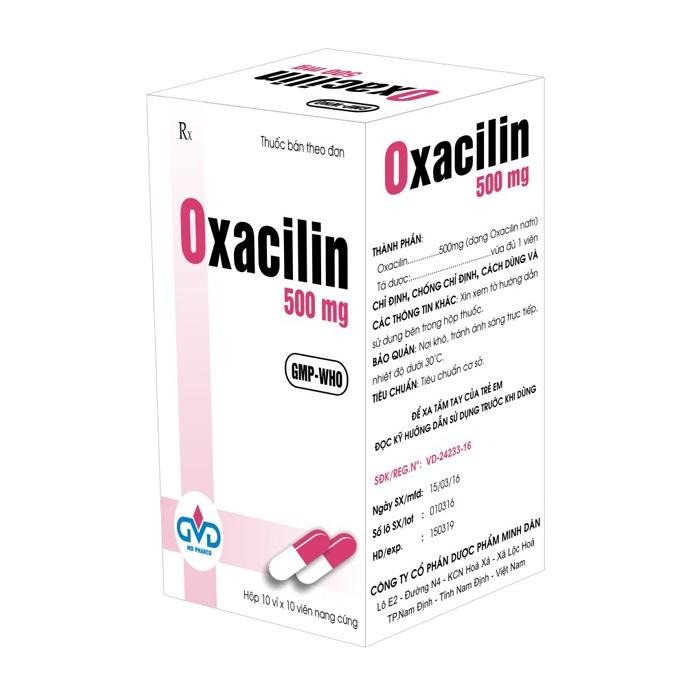Function
Oxacillin is one of the isoxazolyl penicillin (oxacilin, cloxacilin and dicloxacilin).
The isoxazolyl penicillin strongly inhibits the development of the majority of penicillin-producing staphylococci, which are effective against Gram-positive, particularly staphylococci bacteria, that are not affected by bacterial beta lactamase, so are good medication effect treatment. Dicloxacillin was the most potent and most strains of Staphylococcus aureus were inhibited by concentrations of 0.05 to 0.8 micrograms / ml. The inhibitory concentration of cloxacillin is 0.1 - 3 micrograms / ml and of oxacillin is 0.4 - 6 micrograms / ml.
Point
Oxacillin is indicated for the treatment of susceptible infections such as osteomyelitis, septicemia, endocarditis and central nervous system infections due to susceptible penicillin-producing strains. Do not use oxacillin to treat infections caused by methicillin-resistant staphylococci.
Contraindications
Anaphylaxis during previous treatment with any penicillin or cephalosporin.
Careful
Oxacillin has the potential to cause allergic reactions such as penicillin, and therefore must adhere to the usual caution of penicillin therapy. Before initiating treatment with oxacillin, thorough investigation of previous allergic reactions and especially hypersensitivity reactions to penicillins, cephalosporins or other drugs should be investigated.
Pregnancy period
Oxacillin through the placenta. Penicillin use for pregnant women has no adverse effect on pregnancy.
Lactation period
Oxacillin is distributed in milk, but has little or no harmful effect on breastfed babies.
Side effects
Frequent
Nausea, diarrhea.
Foreign.
Thrombophlebitis after intravenous injection.
Less common
Eosinophilia, leucopenia, thrombocytopenia.
Urticaria.
Elevated liver enzymes.
Rarely
Anaphylactic reaction.
Inflammation of the colon has an implant.
Jaundice of the skin.
Ganoderma granules.
Interstitial nephritis and interstitial nephropathy (recovery when promptly discontinued).
To solve
Periodic evaluation of renal, hepatic and haemorrhagic systems should be performed during long-term treatment with oxacillin. Because blood ADRs have occurred during treatment with penicillin-resistant penicillins, the number and formulation of leukocytes should be tested prior to initiation of therapy and one to three times per week during treatment. In addition, urinalysis should be performed, periodically quantifying serum creatinine, AST (GOT) and ALT (GPT) levels before and during treatment.
If there is an increase in eosinophilia, urticaria, or no elevated serum creatinine during oxacillin therapy, alternative anti-infectious therapy should be used.
Dosage and Administration
How to use
Oral sodium oxacillin, intravenous slow or intravenous, or intramuscular injection. Do not use oxacillin when starting treatment for severe infections and when treating people with nausea, vomiting, gastric ulcer, insomnia (esophageal bloating), or increased bowel movement.
Because food influences the absorption of oxacillin through the gastrointestinal tract, oxacillin should be taken at least 1 hour before or 2 hours after meals.
When intramuscular injection is required to inject a large muscle mass, intravenous injection must be slow for 10 minutes to reduce intravenous irritation. When continuous intravenous injection of oxacillin, no injectable additives.
Amount
The dosage is expressed by the oxacillin base.
Oral:
The usual dose for adults and teens to fight bacteria: 500 mg to 1 g every 4-6 hours.
Limit dose usually used adults: Max 6 grams a day.
The usual dose for children to fight bacteria:
Children weighing less than 40 kg: Drink 12.5 to 25 mg for 1 kg of body weight, every 6 hours.
Children weighing 40 kg or more: See the usual dose for adults and teens.
Injection:
The usual dose for adults and adolescents to fight bacteria: Intramuscular or intravenous, 250 mg to 1 gram, every 4-6 hours.
Septicemia or bacterial meningitis: Intravenously 1 to 2 grams, every 4 hours.
Normal dosage for children:
Bacterial Meningitis:
Infants weighing less than 2 kg: Intramuscular or intravenous, 25 to 50 mg per kg body weight, every 12 hours in the first week after birth, then 50 mg per kg body weight, every 8 hours 1 next time
Infants weighing 2 kg or more: Intramuscular or intravenous, 50 mg per kg body weight, every 8 hours in the first week after birth, then 50 mg per kg body weight, every 6 hours later.
All other indications:
Preterm and infant: Intramuscular or intravenous 6.25 mg every 6 hours.
Children under 40 kg body weight: Intramuscular or intravenously 12.5 to 25 mg per kg body weight, every 6 hours; or 16.7 milligrams per kilogram of body weight, every four hours.
Children 40 kg or more: See the usual dose for adults and teens.
Treatment of more severe infections including lower respiratory tract infections or scattered infections and bone marrow infections in children over 1 month of age and less than 40 kg body weight: 100-200 mg / kg per day divided into The same dose, every 4-6 hours.
Dosage adjustment for patients with renal impairment: If creatinine clearance <10 ml / min, use low dose of commonly used.
Duration of treatment: The duration of treatment with oxacillin depends on the type and severity of the infection and is determined by the clinical response and bacteriological response. In severe staph infections, treat with oxacillin for at least 1 to 2 weeks. When treating myelitis - myelitis or endocarditis, the duration of treatment with oxacillin is longer.
Preparation of injection
To prepare the initial solution for intramuscular injection, add 1.4 ml of sterile water for injection into a 250 mg vial; 2.7 - 2.8 ml of diluent to dilute into a 500 mg vial; 5.7 ml of diluent to dilute into 1 g vial; 11.4 - 11.5 ml of diluent to dilute into a 2 gram vial; and 21.8 to 23 ml of dilution to dilute into a 4 g bottle to a concentration of 250 mg in 1.5 ml.
For initial intravenous injection, add 5 ml of sterile water for injection or 0.9% sodium chloride injection in a 250 mg or 500 mg vial; 10 ml of diluted solution in a 1 g vial; 20 ml of diluted solution in a 2 g vial; and 40 ml of diluted solution in a 4 g vial. Slow intravenous injection of solution for 10 minutes.
The drug for intravenous infusion of oxacillin sodium is diluted in a diluted solution to achieve a maximum concentration of 40 mg in 1 ml.
Interactive
Reduction: Penicillin can reduce the effect of oral contraceptives. Tetracyclin can reduce the effect of penicillins.
Increased effect: Disulfiram and probenecid may increase plasma levels of penicillin. Concurrent use of large doses of intravenous penicillin may increase the effect of anticoagulants.
Preservation
Oral solution of oxacillin was stable for 3 days at room temperature or 14 days when refrigerated from 2 to 80C.
The oxacillin solution was kept stable for 3 days at room temperature or 7 days when refrigerated from 2 to 80C.
When mixed for intravenous injection with 0.9% Sodium Chloride Injection solution for 3 days, and mixed with 5% dextrose injection, the oxacillin solution was stable for 24 hours at room temperature.
Incompatibility
Oxacillin sodium may be chemically related to certain drugs, including aminoglycosides and tetracyclines, but the interactions depend on a number of factors (eg, drug concentration, dilution to specific dilutions, pH of the drug). phase, temperature).
Overdose and management
Symptoms of penicillin overdose include nausea and vomiting, electrolyte imbalance with potassium or sodium salts, particularly in kidney failure.
Symptomatic treatment and support. Hemodialysis does not exclude oxacillin.
Medication must be prescribed and over the counter.




